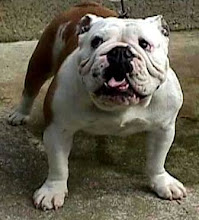Bulldog breeders operate worldwide to propagate various Bulldog breeds such as the American, English and French Bulldogs. Bulldogs originated in England and were originally used to bait bulls. Bulldogs were bred to be aggressive and were often used in dogfights. When Britain passed the Cruelty to Animals Act in 1849, Bulldogs could no longer be used for bull baiting or dog fighting. The original Bulldog, the Old English Bulldog, became extinct, but not before lovers of the breed in England and America bred remaining the Bulldogs with other breeds to create new types of Bulldogs.
The English Bulldog resulted from mixing the Bulldog with the Pug. Smaller, toy English Bulldogs were not as popular and were subsequently exported to France. French prostitutes in particular loved the adorable toy English Bulldog and the dog's popularity spread throughout France. French Bulldog breeders created a sensation by renaming the small, bat-eared Bulldog the French Bulldog, or Frenchie. European immigrants brought Bulldogs with them to America and helped continue to breed in its original form. An American dog breeder, John D. Johnson, bred American Bulldogs, which retain the size and features of the Old English Bulldog.
French Bulldogs are toy versions of the English variety. The two breeds have similar health, behavioral, and social issues. The American Bulldog is much larger but has many of the same predispositions as the smaller English and French Bulldogs. Bulldogs have short muzzles. This makes it difficult for them to breathe. English and French Bulldogs are prone to a reverse sneeze in which moisture becomes trapped in the airway. This can look and sound uncomfortable for both dog and owner. Small Bulldogs cannot regulate their own body temperature and thus should not be left outdoors. They overheat easily and can have heatstroke. Bulldogs may also have skin conditions and eye disorders. Because English and French Bulldogs are indoor pets, they may become obese if not kept active. Female Bulldogs often must deliver puppies by caesarian section due to puppy heads being too big to pass through the birth canal. American, English and French Bulldog breeders can educate potential dog owners about Bulldog health, temperament, and care.
Knowing how to recognize and avoid bad Bulldog breeders is paramount when buying a purebred Bulldog puppy. The following is a list of qualities to look for in good French Bulldog breeders. The lack of one or more of the following is a sign of a bad breeder and is true for any dog breed. Signs of an ethical, legitimate breeder include:
-Breeder maintains his/her own kennel
-Puppies have "house privileges" and have been properly socialized.
-Puppies and parents have received medical screening for common genetic disorders.
-Breeder willingly provides medical and immunization records.
-French Bulldogs with known medical or behavioral problems are not bred.
-Breeder does not sell or broker to pet stores.
-Breeder provides warranty/guarantee of good health.
-Breeder runs or is affiliated with a breed-specific rescue center.
-Breeder interviews buyers thoroughly.
-Breeder only has own litter available at a time.
-Breeder welcomes updates on dog's health and well-being.
Breeder without these characteristics should be avoided to ensure that you are not doing business with a puppy mill or mass breeder.
Buyers should research French Bulldog breeders thoroughly before purchase. How to avoid bad French Bulldog breeders and general Bulldog information is provided in this article.
Subscribe to:
Post Comments (Atom)

No comments:
Post a Comment